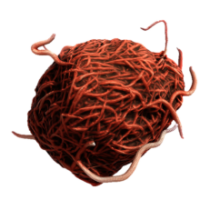
General Information
Mumps is a contagious viral infection caused by the mumps virus. The mumps virus belongs to the family Paramyxoviridae. This family consists of three genera: Paramyxovirus, which includes the parainfluenza viruses and mumps virus; Pneumovirus, which includes respiratory syncytial virus; and Morbillivirus, which includes the measles virus. All paramyxoviruses are enveloped particles 150 to 300 nm in diameter. Before the mumps vaccination became routine in North America, it was a well-known common childhood disease characterized by swelling of the parotid glands, one of three pairs of saliva-producing (salivary) glands, situated below and in front the ears. Complications of mumps, such as hearing loss, are potentially serious, but rare. It is still a significant threat to health in developing countries, and outbreaks still occur sporadically in developed countries, especially in areas with poor vaccine uptakes. Anyone who is not immune from either previous mumps infection or from vaccination can get mumps.
Symptoms
Mumps typically starts with a few days of fever, headache, muscle aches, tiredness, and loss of appetite, and is followed by swelling of salivary glands, which can often be painful. Males past puberty who develop mumps have a risk of developing orchitis, a painful inflammation of the testicles. The symptoms are generally not severe in children. Other symptoms of mumps can include dry mouth, sore face and/or ears and occasionally in more serious cases, loss of voice. In addition, up to 20% of persons infected with the mumps virus do not show symptoms, so it is possible to be infected and spread the virus without knowing it.
Complications
Most people with mumps recover fully. However, mumps can occasionally cause complications, and some of them can be serious. Complications may occur even if a person does not have swollen salivary glands (parotitis) and are more common in people who have reached puberty.
Complications of mumps can include:
- Inflammation of the testicles (orchitis) in males who have reached puberty, which rarely leads to sterility
- Inflammation of the brain (encephalitis) and/or tissue covering the brain and spinal cord (meningitis)
- Inflammation of the ovaries (oophoritis) and/or breasts (mastitis) in females who have reached puberty
- Temporary or permanent deafness
Treatment
There’s no specific treatment for mumps. Symptoms may be relieved by the application of intermittent ice or heat to the affected neck/testicular area and by acetaminophen/paracetamol for pain relief. Warm saltwater gargles, soft foods, and extra fluids may also help relieve symptoms. Acetylsalicylic acid (aspirin) is not used due to the risk of Reye’s syndrome.
Transmission
Mumps is spread by droplets of saliva or mucus from the mouth, nose, or throat of an infected person, usually when the person coughs, sneezes or talks. Anyone who is not immune from either previous mumps infection or from vaccination can get mumps.
Items used by an infected person, such as glasses and cups, or items mouthed by infants, such as toys, can also be contaminated with the virus, which may spread to others if those items are shared. In addition, the virus may spread when someone with mumps touches items or surfaces without washing their hands and someone else then touches the same surface and rubs their mouth or nose.
Most mump transmission likely occurs before the salivary glands begin to swell. Persons with mumps are considered most infectious from 1-2 days before until 5 days after the salivary glands begin to swell. The CDC recommends isolating mumps patients for 5 days after their glands begin to swell.
While transmission of mumps in healthcare settings has not been commonly reported, during community outbreaks, unprotected exposure of healthcare personnel to mumps is common, both in outpatient settings and in the community. These exposures can have a significant impact on healthcare resources.
Prevention
In general, you’re considered immune to mumps if you’ve previously had the infection or if you’ve been immunized against mumps.
A mumps vaccine is the best way to prevent mumps. This vaccine is included in the combination measles-mumps-rubella (MMR) and measles-mumps-rubella-varicella (MMRV) vaccines.
To help prevent the transmission of mumps:
- Minimize close contact with those who are infected; in a healthcare facility, patients suspected to be infected with mumps should be put on isolation/droplet precautions
- Ensure those who are infected stay home from work or school, and limit contact with others
- Wash and sanitize hands regularly
- Cover your mouth and nose with a tissue when you cough or sneeze, and put your used tissue in the trash can. If you don’t have a tissue, cough or sneeze into your upper sleeve or elbow, not your hands.
- Don’t share drinks or eating utensils
- Regularly clean surfaces that are frequently touched (such as toys, doorknobs, tables, counters) a low or intermediate level EPA- or DIN-registered disinfectant.
Environmental Hygiene
The virus can live on contaminated surfaces, such as environmental surfaces (door knobs, faucet handles, light switches) or personal items (cups, utensils) for hours or days. These surfaces can spread the virus to those who are not immune, especially if they share these items or touch contaminated surfaces and then touch their eyes, nose or mouth. Environmental surfaces should be properly cleaned using a disinfectant that is effective against enveloped viruses.
There are many Diversey disinfectants that are effective against enveloped viruses:
See table of recommended disinfectants in the PDF link below.

